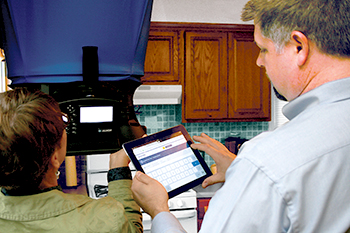Most air balancing hoods are simple to use. As I helped Rob assemble that hood, his first instructions were, “cubba da ho and mash de button” (Cover the hole and press the button).
Once you master the following steps, you will also be on your way to knowing how much air is really moving through a register or grille.
- First: position the hood, so it covers the grille or register completely. Rock the hood away from you to ensure a tight seal over the register or grille before taking your reading
- Second: allow the airflow reading on the hood display to stabilize
- Third: press the button on the hood to record an average airflow
- Fourth: record the measured airflow that shows on the display screen.

As with any instrument you use, understand that every balancing hood has some limitations. Some of the most common balancing hoods read airflow over 30 cfm, but any reading less than this will show a zero on the display.
The maximum airflow limit that most balancing hoods can read is 2000 cfm. Make sure you read the instruction manual for your hood. Know its limitations and how to best use it.
How Many Boxes of Air Would You Like?
Once you have confidence in your ability to use an air balancing hood, it’s time to use it to create a customer experience like no other. As you use the hood to teach your customers about their HVAC system, it becomes a differentiator. It helps you stand out.
For the hood to work most effectively with a customer, there must be pain. Getting your customers interested is much more challenging if there’s no pain. Your questions often reveal pain points. Some are obvious. Others are not. Consider how doctors ask you, “Where does it hurt?”
Chuck Worley of Worley’s Home Services in Yorktown, VA, has one of the best questions I’ve heard about getting to pain points. He asks his customers where they would like another thermostat in their home. The answer often reveals the most uncomfortable room and an opportunity to use the balancing hood.

them in control. It changes the conversation
and allows them to make smart decisions.
This approach to questioning changes the conversation. It moves the discussion beyond equipment to the system and the repairs necessary to correct any problems. Another benefit is this process puts the customer in control of their buying decision instead of being at your mercy. They are in control. They decide based on data from their investigation.
Before you take the first airflow measurement with a hood, you need a target. An airflow measurement without one is useless. That’s because there is no context for the reading.
NCI teaches a quick and easy way to estimate room airflow in our Duct System Optimization class. It helps the customer set airflow targets and then see how close the balancing hood measurements are. The entire process is fun and engaging. Contact me for a single-page report and procedure if you want to learn more about estimating room airflow.
Once you set the airflow target, it’s time to let your customer discover a new side of their HVAC system. It’s one that few in our industry look at – delivered airflow.
The Excitement of Discovery
Your best use of a balancing hood is when you don’t use it. That’s right. Instead, let your customer measure room airflow. Put the hood in their hands and let them see how much airflow is coming into their problem room. Their responses are the best, so look for them. I’ve seen everything from puzzled looks to frustration. Be ready for anything.
Click Below for the Next page:













Hi David
How well does a balancing hood measurement perform on a slim duct unit (mini split units) where airflow really small.
Hi Serge,
A balancing hood wouldn’t be the best way to capture airflow from a mini split. It would be hard to take the measurement. Another option would be to traverse the discharge with a rotating vein anemometer.